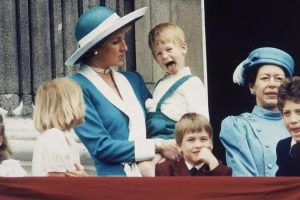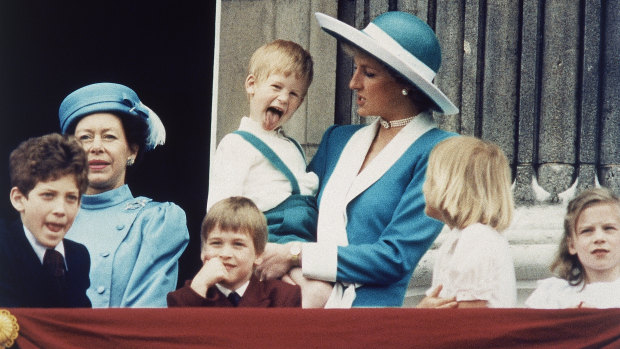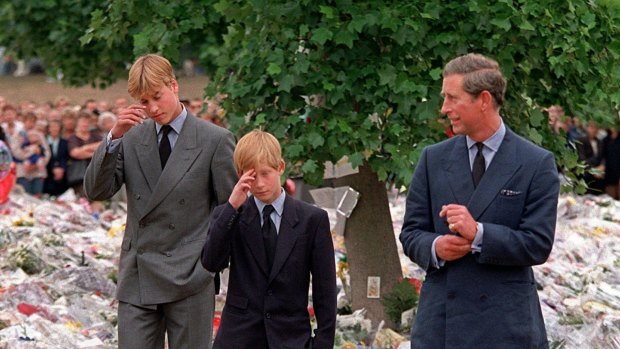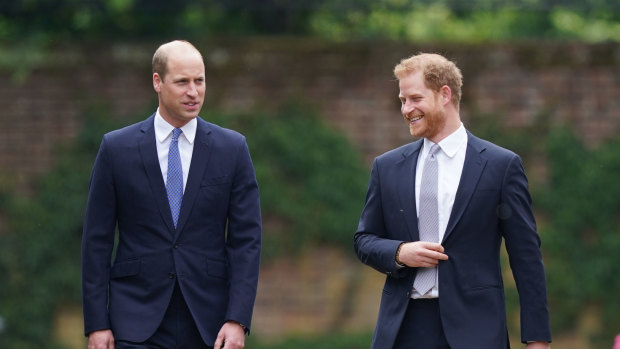Prince Harry’s pain common for survivors of childhood trauma

In his rational mind, Prince Harry knew an attempt to invoke the spirit of his dead mother through a medium could involve, in his words, a high chance of “humbuggery”. But he so desperately wanted to be close to her. “The minute we sat down together,” the Duke of Sussex wrote of his meeting with the unnamed conduit, “I felt an energy around her”.
The woman told him his mother felt his confusion, and was with him “right now”. Diana, she said, knew her son was looking for clarity. “You’re living the life she couldn’t, you’re living the life she wanted for you.” For a brief moment, Harry felt validated and comforted by the mother he has mourned since he was 12.
Diana with her son Harry in 1998.Credit:AP
Childhood trauma has a long tail. Psychologists know more about its profound, lasting impacts than they did in 1997, when Diana died in a violent car crash in a Paris tunnel, and 2 billion people watched her sons walk behind her coffin. Harry faced other traumas, too, in his gilded cage. His parents’ bitter divorce, played out in the public eye; a life of media scrutiny; and an eccentric, hierarchical family, with a sibling who would always take precedence and who Harry both loved and considered an “arch nemesis”.
“That trauma has stayed with him,” says Juliet Rieden, the author of Royals in Australia. “We know this is common for anyone who’s had a traumatic childhood. We are seeing that now, and it’s difficult to watch. It is playing out now in a very public way.”
The duke’s anguish over the loss of his mother is a constant theme in his memoir Spare, which will be published in Australia on Wednesday but accidentally went on sale, despite strict secrecy measures, in Spain. He writes in harrowing emotional detail about the time when, aged 23, he was in Paris for the Rugby World Cup, and insisted on driving through the Pont de l’Alma, the tunnel in which his mother died at the same speed as her car, 65 miles per hour.
“Off we went, weaving through traffic, cruising past the Ritz, where Mummy had her last meal, with her boyfriend, that August night,” Harry wrote. “Then we came to the mouth of the tunnel. We zipped ahead, went over the lip at the tunnel’s entrance, the bump that supposedly sent Mummy’s Mercedes veering off course. But the lip was nothing. We barely felt it.”
Charles, then the Prince of Wales, accompanies his sons Prince William (left) and Prince Harry to view flowers left in memory of Diana. Credit:AP
Within seconds, they emerged on the other side. He asked himself, “Is that all of it? It’s … nothing. Just a straight tunnel.” He had always imagined the tunnel as “some treacherous passageway, inherently dangerous, but it was just a short, simple, no-frills tunnel.
“She’s dead, I thought: ‘My God, she’s really gone for good,’” he continued. “I got the closure I was pretending to seek. I got it in spades. And now I’d never be able to get rid of it. I’d thought driving the tunnel would bring an end, or brief cessation, to the pain, the decade of unrelenting pain. Instead, it brought on the start of Pain, Part Deux.”
The boys’ trauma began before Diana’s death. There was the public disintegration of their parents’ marriage, in which both Charles and Diana engaged in the kind of tell-all television interview Harry is now emulating. They often, according to multiple biographies, dragged their boys into their disagreements. There was the mistress who eventually became their stepmother. And for Harry, there were persistent rumours about his true father, all played out on the front pages of Britain’s newspapers.
“As a psychologist, it’s no surprise that there would be, decades later, these sorts of issues in a family where the kids have suffered in the way they have in those early years,” says Anne Hollonds, the national children’s commissioner. “Any family would be seeing something like that.”
Harry describes Wililam (left) as both his arch nemesis and beloved brother.Credit:Getty Images
The impact of childhood trauma can be lifelong, says Barnardos’ Australia’s head of research Robert Urquhart. In adulthood, victims can experience unpredictable emotions, isolation, poor boundaries and strained or toxic relationships. “Even over-sharing can be a trauma response, trying to make connection with others,” he says. “Not knowing who is a safe person is a big one, and not knowing who I am in terms of my identity.”
Harry believes he never got the help he needed. There was little understanding of childhood trauma then; now, psychologists know more about what causes it – which ranges from abuse to the sudden or violent loss of a loved one – and how to reduce the long-term damage. “That attitude of ‘stiff upper lip, get on with it’, has changed and hopefully we have a more compassionate, supportive response,” says Cathy Kezelman, the executive director of the Blue Knot Foundation, which focuses on recovery from complex trauma.
Back then, however, Harry says Charles made light of the paternity rumours – the most persistent of which was that he was sired by Diana’s riding instructor and lover, the ginger-haired James Hewitt. In Spare, he reveals his father, while philosophising about the nature of reality, asked, “who knows if I’m really the Prince of Wales? Who knows if I’m even your real father? Maybe your real father is in Broadmoor, darling boy!” The duke claimed that his father would laugh at this joke even though it was “remarkably unfunny”.
The duke also reveals his resentment towards Camilla, the Queen Consort and the woman Diana described as the “third person” in her marriage to Charles, arguing she had played a role in his mother’s death because she was pivotal to his parents’ divorce. Harry says his first meeting with her was like “getting an injection”, and he told himself he should close his eyes and “you won’t even feel it”. He claims she was bored during their meeting because any objection from Harry, as the “spare”, would not be a significant obstacle to her marrying Charles.
Harry and William agreed to forgive her, but “begged” them not to marry and invite comparisons with Diana. Harry accused Camilla of not wasting any time in developing a campaign to marry Charles, alleging that she “sacrificed” him to improve her own public image and leaked details of a conversation with Prince William to the press.
Spare is Harry’s story. His brother, Prince William, who went through similar experiences, would tell a different version. Even when an incident involves both of them – such as Harry’s accusation that his older brother “grabbed me by the collar, ripping my necklace, and he knocked me to the floor” during an argument – their “recollections may differ”, as the late Queen Elizabeth said in response to some of her grandson’s earlier revelations.
The family dysfunction of the Mountbatten-Windsors’ is playing out in front of an audience of billions. It is more than a soap opera; the characters play a core role in the British – and Australian – constitutions, a role under increasing scrutiny in the modern era. The book follows a series of tell-all interviews from Harry and his wife Meaghan, and there are more to come. Many are wondering what the duke hopes to achieve through the public airing of private pain.
Partly, it’s because Harry feels misrepresented, and wants to set the record straight, says Rieden. But as he has also said, “Harry feels this is the only way he can get through to his family. We may say, ‘why don’t you just go and talk to each other?’ Harry points out that it’s not as easy as it is in any other family. I don’t think he’s being disingenuous.”
In a Good Morning America interview, due to air on Monday, Harry says he does not think he can have peace with his family unless “the truth is out there”. He acknowledges Diana would be “sad” about the rupture with his brother, but “I think she’d be looking at it long term, to know there are certain things we need to go through to heal the relationship”.
The Morning Edition newsletter is our guide to the day’s most important and interesting stories, analysis and insights. Sign up here.
Most Viewed in World
From our partners
Source: Read Full Article



